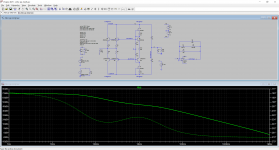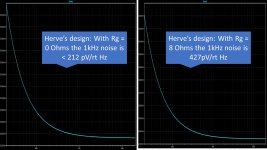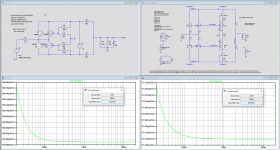I would argue the gain in the first stage needs to be high enough so it dominates the total noise of the phono stage. Above that point is preference, unless your second stage is really shonky.
I've avoided the can of worms of what the second stage would ideally be to mate with a common base headamp mainly because my requirements are unusual and I'm setting levels to go flat into an ADC even though it is interesting (at least to me) when you throw away convention.
I've avoided the can of worms of what the second stage would ideally be to mate with a common base headamp mainly because my requirements are unusual and I'm setting levels to go flat into an ADC even though it is interesting (at least to me) when you throw away convention.
I would argue the gain in the first stage needs to be high enough so it dominates the total noise of the phono stage.
Very lax criteria, a gain of 15-20dB would already make any decent second stage (usually the 75uS pole) noise irrelevant. Probably the worst use case (from a noise perspective) would be a head amp feeding a mediocre JFET input MM preamp, with say 4nV/rtHz. But then even a MM preamp with a modern 8 leg JFET monster can go well under this.
By pure chance I hit this site mysonicspace-Phono cartridge impedance loading. Then I realized that the "The effect of different impedance loading on a moving coil phono cartridge frequency response" chart can be found in an awful lot of sites promoting the optimum MC cartridge loading of 100ohm.
Any idea where this chart is originating from? I can't find any technical argument justifying such a huge increase in the HF response at large loading impedances, what am I missing? Or this is yet another audiophile myth?
Any idea where this chart is originating from? I can't find any technical argument justifying such a huge increase in the HF response at large loading impedances, what am I missing? Or this is yet another audiophile myth?
Any idea where this chart is originating from? I can't find any technical argument justifying such a huge increase in the HF response at large loading impedances, what am I missing? Or this is yet another audiophile myth?
I can't make any sense of this, talks about step-up transformers but how could you ever present 100k to the cart with any transformer? There is also this...
The plus side is that noise produced from a passive device is non-existent
I can't make any sense of this, talks about step-up transformers but how could you ever present 100k to the cart with any transformer? There is also this...
Here's another reference, the chart is identical, this is certainly copied from somewhere:
Discussion on MC Cartridge Loading
Accompanied by the usual garbage "electro-acoustic transducers must be damped to avoid ringing, overshoot and other negative effects".
One useful thing possible when fed from an active stage is an inverting second stage. No common mode issues and no unity gain stop in the RIAA feedback.
All good fortune,
Chris
Yes, and also use the first stage current out and second stage as current amplifier.
Attachments
Yes, and also use the first stage current out and second stage as current amplifier.
You need 2SK363 BL or V grade (Vp<-0.5V) and to cross your fingers. The JFET will be at the very limit of saturation, too close to my taste to the linear region. Vds>Vgs-Vp~-0.5+1.2=0.7V since Vpmax=-1.2V. It could work, but I personally would not use such a JFET active load for a power supply voltage of less that 3.5V. Otherwise, for 2.5V, you have only 1.25V for a Vbe of 0.6V and the remainder 0.65V to keep the JFET in saturation.
I'm not sure but if I remember correctly, this chart is from the very early days of MC cartridges and was published by ORTOFON?. What it shows is that the cartridges then had severe mechanical resonances - in this case around 17 to 18 kHz with a highisch Q resulting in an up to 12dB amplitude rise. A transformer at those times was the only practical step up devices as very low noise transistors were not available. By loading the transformer step up, a significant reduction of such frequency rise could be achieved. This however on the expense of already severe attenuation in the 3 to 5 kHz range. The 'best' universal compromise was something around 100 R loading. And this may be the foundation of the 100R or 10x the cartridge resistance myth and the reason to play with the loading. When later these resonances could be shifted more towards 25 to 30 kHz and even later cold be damped much better all this loading became much less critical - but the myth was manifested and gets repeated all the time.Here's another reference, the chart is identical, this is certainly copied from somewhere:
Discussion on MC Cartridge Loading
Accompanied by the usual garbage "electro-acoustic transducers must be damped to avoid ringing, overshoot and other negative effects".
What the graph also shows is that the mechanical resonance can not be damped effectively by electrical loading - it is only taken down as part of a low pass function starting already in the 2 to 5kHz range. And the much better way would have been a serial resonance shunt circuit - but this would have had the requirement to be tuned individually to each cartridge.
Here are the noise analysis results using the models I have. I used BF862 for the JFET's.
This is a very impressive design Herve - thank you for sharing!
I hope you don't mind, but I'd like to add it to the compendium.
This is a very impressive design Herve - thank you for sharing!
I hope you don't mind, but I'd like to add it to the compendium.
Attachments
Last edited:
Here's another reference, the chart is identical, this is certainly copied from somewhere:
Discussion on MC Cartridge Loading
Accompanied by the usual garbage "electro-acoustic transducers must be damped to avoid ringing, overshoot and other negative effects".
I can only speak from measurements with my Benz Cart.
100R, 1K or 47K load does not change the FR the least, only the output level changes a bit, just as expected, which by the way is not visible in the test you refer to.
So I think that a very weird Cart must have been used or it is just plain BS.
Hans
Those look like MM frequency responses when incorrectly loaded. Safe for us to ignore.
It does intrigue we that ortofon used to make it part of their sales pitch that FR didn't matter as much as phase response when they came up with their 'orthophase' ideas.
On/off topic: My ongoing mildly obsessional hunt for odd and interesting cartridges is currently focussed on the ortofon MC100. This comes from the age of plug replacable MCs so it looks just like the MM concorde. As there is not much space for the generator it's lowish output and DCR (0.1mv and 3Ohms) and bucked the trend at the time for ortofon moving to more sensible outputs.
The interesting part is the mass/compliance combination. 11cu and 2.3/5.3g depending on if you add the optional weight. Too low compliance for my light arm, but would be perfect for the 9.5g SME309 giving a 13Hz ish resonance. Intriguing...
It does intrigue we that ortofon used to make it part of their sales pitch that FR didn't matter as much as phase response when they came up with their 'orthophase' ideas.
On/off topic: My ongoing mildly obsessional hunt for odd and interesting cartridges is currently focussed on the ortofon MC100. This comes from the age of plug replacable MCs so it looks just like the MM concorde. As there is not much space for the generator it's lowish output and DCR (0.1mv and 3Ohms) and bucked the trend at the time for ortofon moving to more sensible outputs.
The interesting part is the mass/compliance combination. 11cu and 2.3/5.3g depending on if you add the optional weight. Too low compliance for my light arm, but would be perfect for the 9.5g SME309 giving a 13Hz ish resonance. Intriguing...
Hans, as I wrote in my previous post.I can only speak from measurements with my Benz Cart.
100R, 1K or 47K load does not change the FR the least, only the output level changes a bit, just as expected, which by the way is not visible in the test you refer to.
So I think that a very weird Cart must have been used or it is just plain BS.
Hans
Such response curves were the norm in the very early MC cart days (more than 50 years ago). Cartridges had severe mechanical resonances due to cantilever mass etc and due to the non availability of damper materials with high enough damping factors. The next steps were reducing moving mass and lastely also using damping rubber materials with improved damping properties. As a result, modern MC cartridges do not show such behaviour at all - resonances are shifted to higher frequencies above the audio band and are well damped. Carts with severe frequency peaks in the 15 to 20 kHz range are history.
These are not MM curves, they are indeed MC in combination with a step up transformer - but as said 50 years agoThose look like MM frequency responses when incorrectly loaded. Safe for us to ignore.
(0.1mv and 3Ohms)
[/QUOTE
... a challanging cart. The theoretical max. S/N with a noiseless step up/preamp will be 70dB. Still ok. Step up / gain of more than 30 dB required to bring it to MM signal level.
Adding a second set of parallel transistors to the Duraglit, will also reduce noise by 3db in a simulation !
Here the Richard and Herve versions, where the Duraglit scores lower in noise.
The pure simplicity of the Duraglit, despite some Hfe concerns, is still a thing of beauty to my eyes.
Hans
Here the Richard and Herve versions, where the Duraglit scores lower in noise.
The pure simplicity of the Duraglit, despite some Hfe concerns, is still a thing of beauty to my eyes.
Hans
Attachments
Last edited:
You need 2SK363 BL or V grade (Vp<-0.5V) and to cross your fingers.
The level 1 JFET model gives basically garbage answers near the edge of saturation.
Adding a second set of parallel transistors to the Duraglit, will also reduce noise by 3db in a simulation !
Hans
It might be useful to do a sensitivity analysis on device match for paralleling.
- Home
- Source & Line
- Analogue Source
- Richard Lee's Ultra low Noise MC Head Amp


